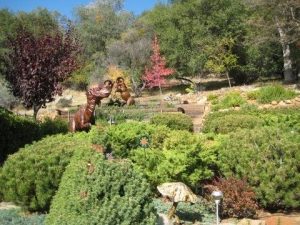When I moved into my present residence, I was told by the previous owner the landscaping of the property was created to embrace wildlife. This was somewhat new to me. Previously I had planted a few perennials to entice hummingbirds and pollinators, but that was about the extent of my wildlife habitat gardening. After living here and learning more through observing the activity in my garden, I now recognize the importance of the practice of habitat gardening.
Daily, we love to observe the birds, squirrels, amphibians, reptile and insect activity in our garden. However, besides our personal enjoyment there are other reasons to grow and maintain a wildlife garden. A prime example is the butterfly population. Many species of butterfly are exhibiting a decline in numbers. The decline is not only being observed in urban and suburban gardens, but also in wildlands. Along with the butterfly populations, toads, frogs, bees and some songbird species are declining as well. Though the cause of the decline cannot be narrowed down to one specific reason, the rapid loss and degradation of habitat in California is a chief concern. Perhaps now we need to change our view on gardening. We, as the urban and suburban gardeners, have to come to the rescue of our wildlife.
We can help to restore a small part of what has been lost. When we create habitat we’re helping to restore a small part of what has died out. These creatures clean up excess seeds and bugs, pollinate our fruits, vegetables, and flowers, prevent disease in the garden and fascinate us with their relationships to each other and with the plants they depend on for survival.
Regardless of the wildlife focus, it is abundantly clear when you plant for one you plant for all. A diversity of plants brings insects, who supply feed for birds, toads, frogs, lizards, and the predaceous and parasitic insects we call “beneficials.” Nectar flowers bring in hummingbirds, bees, butterflies, and other pollinators.
Turning your garden into a wildlife habitat takes no special training or skills. All animals need shelter, foraging sites, and places to nest and breed. Nature will give us the cues. Wilderness areas that contain the most diverse animal species also contain the most diverse plant species.*
The California Native Plant Society site has a lists of plants native to the Sierra foothills area: calscape.org/loc-Sonora,CA/cat-All-Plants/ord-popular.
Wendy Weidenman is a University of California Cooperative Extension of Tuolumne County Master Gardener
* Bauer, Nancy The California Wildlife Habitat Garden, University of California Press 2012. Wendy





